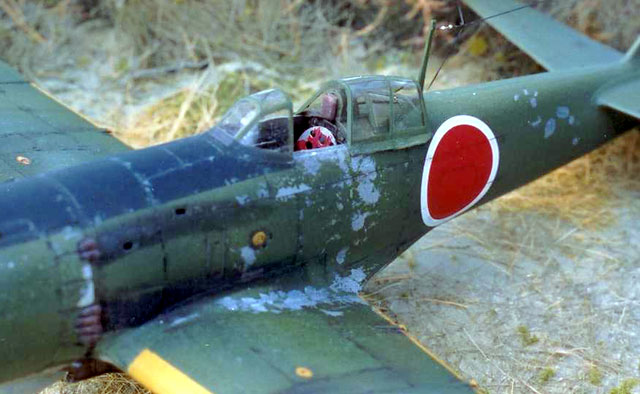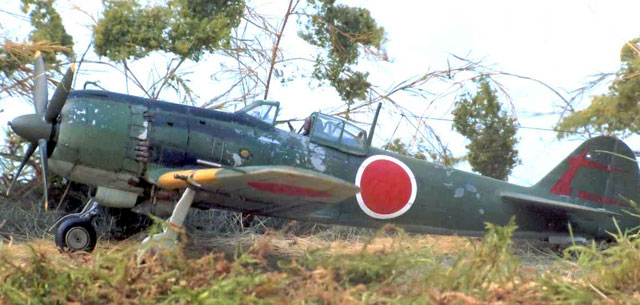|
Ki-84 Hayate ‘Frank’
by Andrew Johnson
 |
|
Ki-84
Hayate ‘Frank’ |

Hasegawa's 1/48
scale Ki-84 is available online from Squadron.com
This is the Hasegawa 1/48 Ki-84 ‘Frank’, one of the nicest kits around, and
one of the most attractive fighters ever built. As will soon become obvious, I
am one of the modellers who has succumbed to ‘la maladie du rond rouge’
as Olivier Chapon described it in a recent edition of Wing Masters.
Cockpit
The cockpit is one of the best in 1/48 scale, but of course can still be
improved on with the relevant Eduard photo-etch set. The best part of this set
is the seat which has been cleverly designed to represent the original design
with its characteristic step (presumably to accommodate a back parachute pack).
The Japanese interiors book by Robert Mikesh and published by Monogram is an
essential aid to those afflicted by the maladie du rond rouge and enables
a virtually perfect cockpit to be constructed.
The problem, that bedevils all modellers of Japanese aircraft is what colour
to use in the cockpit. As no original interior paint can be seen on the
surviving Ki-84 the field is open to debate. After discussion with Peter
Starkings, the leader (Hikotaicho?) of IPMS SIG on Japanese aircraft I went for
a dark green. I think in this case I used the Aeromaster ‘Mitsubishi interior
green’.
But what about the seat?
A surviving Ki-84 seat is shown in the Mikesh book as having a sort of red
oxide primer paint. To recreate this I used a Humbrol aluminium enamel, and then
using the Mikesh photo as my guide, I placed small blobs of maskol with a tooth
pick on the worn areas of the seat. The seat was then painted with gunze acrylic
red and the Maskol prized off with a scalpel blade. This leaves the
weathering/chips where you want it.

The various knobs were then painted in the colours of the surviving Ki-84,
which are clearly shown in the Aero Detail book on the Ki-84. In the Mikesh
book, the lap belt in the restored Ki-100 at RAF Cosford is described as an
original JAAF belt, so this is a reasonable guide for other JAAF fighters. The
belt is a very dark brown, if not tea colour with brass buckles and holes. The
Aeromaster Japanese red-brown primer does very well as this sort of leather
(thankyou Steve Abbey). The overall cockpit was then finished in the usual oil
wash.
Engine
The engine cylinders were painted a 50:50 mixture of Humbrol Metalcote and
Aluminium, whilst the cylinder heads were painted aluminium. I came up with this
variation from examining photos of contemporary radial engines, in which the
different direction and distance of the cooling fins between the cylinder and
cylinder head gives this two tone appearance. I used the Eduard ignition
harness, but used several coats of gloopy Humbrol water line red colour to help
give them a more 3-dimensional feel.
Following the Aero Detail book I added additional oil return pipes to the
Homare engine, before finishing with a black oil wash. The cowling gun ports
were drilled out as were the gun exhaust and cartridge chutes.
Undercarriage
The model does have a practical problem, as reported by many modellers, in
the use of vinyl grommets to locate the main undercarriage legs. This tends to
make the undercarriage splay forward too much under the weight of the aircraft.
I glued my undercarriage into their grommets, only to find them snap off shortly
afterwards!
I laboriously drilled holes in the oleo legs and wing stubs to fit a 2 mm
brass rod. This allows you to repair the undercarriage and get a strong join. As
you will have gathered, this a repair I have had to do on more than one
occasion!
The model is designed to have its butterfly flaps deployed. To keep them
retracted I used a scalpel to cut out the flap interior of the lower wing
section. This, together with a bit of sanding will then allow them to sit in the
retracted position, which was normal for aircraft standing on the ground.
I spray painted the aircraft first in SnJ aluminium before applying a coat of
Johnson’s Klear. Where I definitely wanted the bare metal to show through I
applied blobs of Maskol. Then I sprayed Aeromaster Japanese army undersurface
grey and Nakajima Army green on the uppersurface. I wasn’t entirely happy with
the look of the patches of worn paint following the Maskol blobs, so did extra
scraping with my pen knife, which as you might guess is rather blunt.
Having read the account of the loss of the Major McGuire and Major Rittmayer in
their P-38 Lightnings on 7th January 1945 over Negros Island in the Philippines
I wanted to paint my Ki-84 as the 71st Sentai aircraft involved in the fight. I
first read this story in the Osprey book of P-38 aces in the Pacific by John
Stanaway.

I got extra details on the Ki-84 pilot Sgt Mizunori Fukuda by Katsuhiro
Uchida and David Aiken at j-aircraft.com.
Major McGuire’s flight of four P-38s’ (McGuire, Thropp, Weaver, Rittmayer)
tangled first with a single Ki-43 of the 54th Sentai, the low level dog fight
ended with McGuire crashing into the ground. Fukuda spotted the dogfight as he
came in to land at nearby Manapla airfield and joined in to shoot down Major
Rittmayer, his aircraft was hit in return by Weaver and then escaped to crash
land back at Manapla airfield.
The damaged Ki-43 crash landed and its pilot, WO Sugimoto was shot by
Filipino partisans. Fukuda survived the war. My only reference on the tail
marking of the 71st Sentai was Peter Scott’s book on JAAF insignia ‘Emblems of
the rising sun’ by Hikoki. I recreated the simple red marking using masking
paint and Gunze acrylic red.
Hope you like it!
Click
the thumbnails below to view larger images:
Model, Images and
Article Copyright © 2002 by
Andrew Johnson
Page Created 31 August 2002
Last updated 04 June 2007
Back to HyperScale Main Page
Back to Features Page |
Home
| What's New |
Features |
Gallery |
Reviews |
Reference |
Forum |
Search